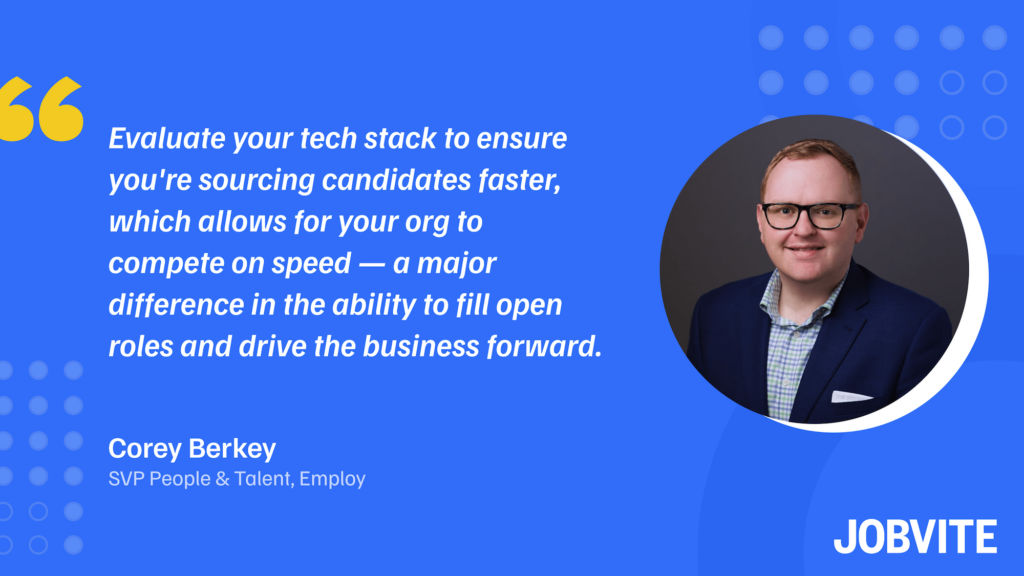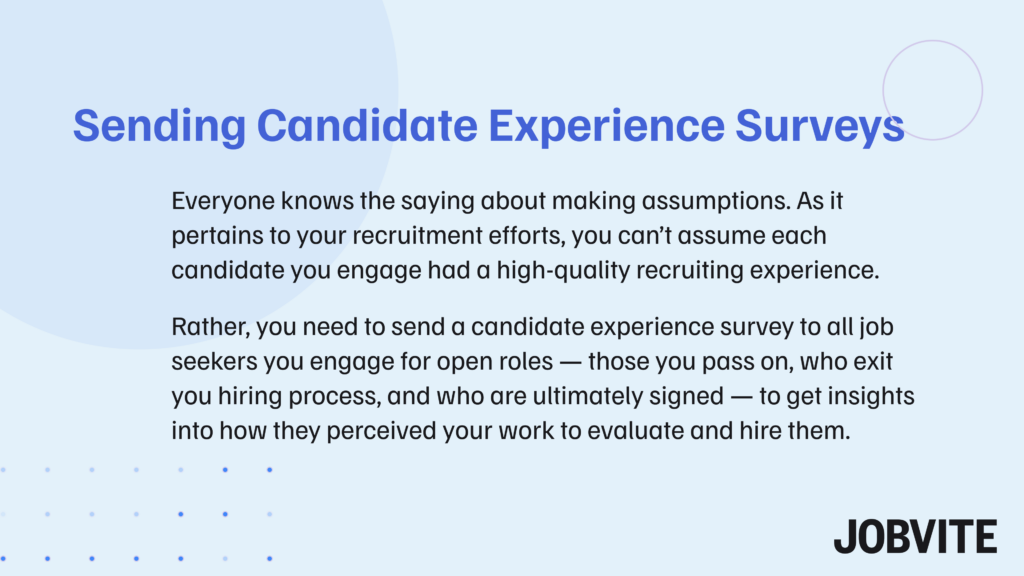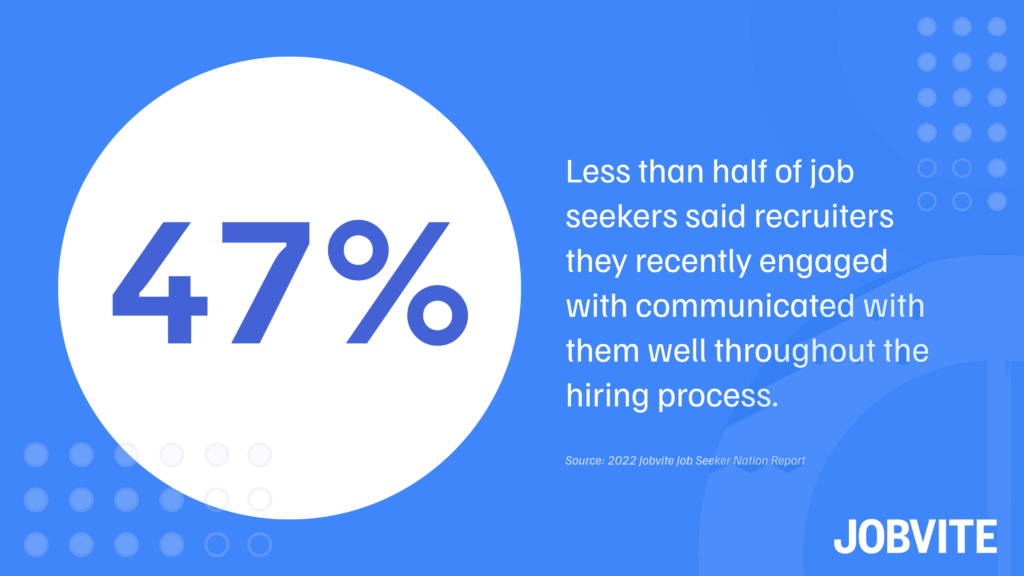When you think of candidate experience best practices, what exactly comes to mind for your talent acquisition team? Does it include accurate job descriptions? An straightforward application process? Easy-to-schedule interviews? What about prompt feedback and communication?
In short, the candidate experience includes all the feelings, impressions, interactions, and activities a job seeker encounters and considers along their candidate journey:
From the moment they land on your careers page to apply to job postings, to the interview process with recruiters and hiring managers, to the offer stage.
The goal for your TA ad HR teams is to find ways to improve the candidate experience over time through data-based changes to your recruitment process and onboarding processes. Only then will candidates feel like they’ve been “taken care of” throughout the entirety of their brand engagement.
That’s where learning — and always abiding by — candidate experience best practices comes into play.

What a “great” candidate experience entails
“Great” is subjective.
That said, there are certain areas all successful talent teams focus on improving over time to ensure good-fit prospects they add to and advance in their pipelines have a strong recruitment experience.
Simply put, the best recruiting orgs utilize a premier applicant tracking system to:
- Deliver consistent employer brand messages
- Tailor content and experiences to each candidate
- Secure personalize talent recommendations
- Post jobs to mobile-optimized career sites
- Provide a simplified job application process
- Streamline interview scheduling for job seekers
- Automate messaging to each prospective hire
- Leverage artificial intelligence and automation
- Offer regular updates on the entire hiring process
Whether it’s making leads feel valued during the application process, providing helpful feedback or communication, or treating them with professionalism and respect after their candidacy has ended, the candidate experience encompasses every interaction a candidate has with an employer.
The key to making progress in these above facets of your talent acquisition efforts?:
Ensuring you have a well-crafted talent acquisition strategy — and the right recruitment solution at the center of your tech stack.
“Evaluate your tech stack to ensure you’re sourcing candidates faster, which allows for [your org] to compete on speed — a major difference in the ability to fill open roles and drive the business forward,” Employ SVP People & Talent Corey Berkey recently wrote for Forbes.

Why candidate experience is so important
Candidate experience matters to the success of your org more than you may think.
Providing a quality CX allows you to find and recruit top quality talent to impact the success of your business. In other words? A strong candidate experience ensures you can build a robust talent pipeline and employer brand that will strengthen your reputation relative to competitors.
But, the problem in today’s recruiting climate is that positive candidate experiences are declining. In fact, candidate resentment is on the rise, spiking 75% recently to more than 14% of candidates.
The Talent Board noted the decline of favorable candidate experiences “impacts whether or not candidates are willing to apply, refer others, be a brand advocate, and/or make purchases from a consumer-based business.” (A lot of wide-ranging impacts, no?)
Translation? The impact of negative experiences not only influences your ability to attract top talent, but can also have a lasting effect, when it comes to wanting to spend money at your org as well.
So, when it comes to achieving better hires, how can you leverage candidate experience best practices to positively impact your business outcomes? Let’s look at three ways.

1) A stellar CX can help augment your talent pool
Companies typically spend significant time promoting their brand in the marketplace.
But, if they fail to pay the same attention to the candidate experience, they can erode their ability to attract new talent to the business and convert them to the application stage.
Yet, with strong employer brand messaging, personalized job recommendations, tailored content, and automated or intelligent messaging, companies can successfully broaden their talent pipeline and better convert candidates into applicants.
In fact, one study from Appcast found an easy to apply process that was five minutes or less enabled companies to increase applications rates by up to 365%.
Think if you had this big of a rise for your open roles the difference it could make in quickly filling them.
By acknowledging candidates, your company benefits from an engaged talent pool, thus increasing the number of legit opps in your pipeline to help your hiring team extend offers to premier prospects.
Simply put, delivering a positive CX that empowers candidates and makes them feel confident in applying to an open position is a major step in delivering better recruiting results for your business.

2) Happy candidates equals better employer brand
Providing a great candidate experience is not that difficult. And that’s why job seekers get so frustrated if they encounter experiences that make them feel unappreciated or robotic.
No one wants to spend an hour filling out the same info for an application that was already in their resume to begin with. With the intelligent talent acquisition tech available today, there is no excuse for employers to provide a poor candidate experience. Having the right tech matters.
Even companies that receive hundreds of applications per opening can use an advanced ATS to ensure every applicant feels heard. (That is, recruiters respond to them post-application quickly.)
Remember: When job seekers have a bad experience, they are likely to tell others. Talent Board research 33% of job seekers who have a bad CX will post about it online. That means it’s possible their comments may come up in search results. (Not ideal for your brand reputation.)
However, SHRM reports when you effectively communicate with candidates in each step of the hiring process, they’re far more likely to report a positive experience with your company.
Any time your brand interacts publicly, it must provide a positive experience. Plain and simple.
The Content Marketing Institute reported that 89% of B2B marketers believe that brand awareness is more important than sales and lead generation. In short, a poor candidate experience harms the organization by damaging its brand and resulting in lower-quality hires.
3) Your org’s quality of hire can spike substantially
So much of the candidate experience comes down one thing: Candidates want to be valued. It’s likely that the individuals applying to your organization already feel frustrated, anxious, or stressed.
Your candidate experience is not just a process in itself. It is a mechanism for enhancing your relationship with job seekers. And it influences the quality of talent that is coming into your org.
Engaged candidates also make better hires who will stay longer in your company.
One study even suggests more than nine in 10 senior HR pros agree that quality of candidate experience directly impacts quality of hire. And the best way to engage them is ensuring they have a positive impression and experience from first look to first day.
This is particularly important based on the current labor market with one in three hires leaving in their first 90 days after joining a company. (That’s a lot of wasted time for your talent team.)
To communicate consistently, provide a streamlined process. Give leads what they want and need to know. By doing so, you motivate top talent to accept your job offer even before a competitor has a chance to extend one. Something that can help your org scale and grow as desired.
Make ongoing progress with your candidate experience efforts by using an advanced ATS. Speak with a Jobvite rep today to learn about our complete Talent Acquisition Suite.





